US Dollar Exchange Rates of
25th
May
2024
China Yuan 7.24
Report from China
Industrial capacity utilisation
A press release from the National Bureau of Statistics
provides data on industrial capacity utilisation. In the first
quarter of 2024 the industrial capacity utilisation rate for
surveyed industrial enterprises was 73.6%, down by 0.7
percentage points from the same period in 2023 and 2.3
percentage points down from the previous quarter.

See:
https://www.stats.gov.cn/english/PressRelease/202404/t20240424_1955021.html
First quarter investment in real estate
Between January and March investment in real estate
development was 2,208.2 billion yuan, a year-on-year
decrease of 9.5%, of which the investment in residential
buildings was 1,658.5 billion yuan, down by 10.5%.
See:
https://www.stats.gov.cn/english/PressRelease/202404/t20240424_1955015.html
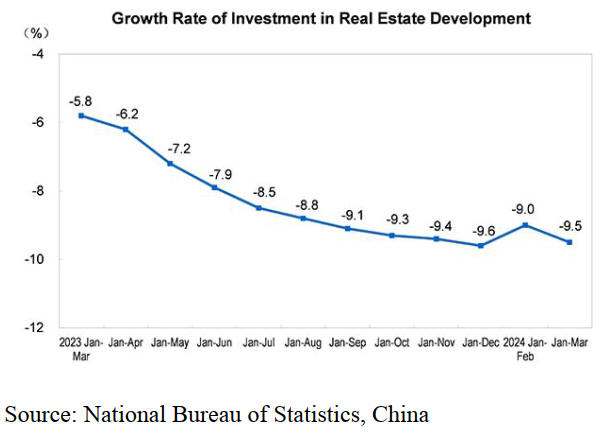
Plans to stabilise real estate market
China’s housing market slumped after a change in
government policy on borrowing by property developers
and the decline in the sector sunk other businesses such as
home furnishing, appliances and construction.
Real estate has long been important for China’s economy
driving its rapid growth however, this came with risks.
Home prices rose sharply relative to household incomes in
the years before the pandemic, in part because consumers
preferred to invest their savings tangible assets, but that
has changed. Home sales have fallen as potential buyers
see prices falling and some developers unable to secure
financing to complete projects.
With the property downturn now in its third year, there has
been a hollowing out of the real estate sector. Housing
starts have fallen by more than 60% relative to pre-
pandemic levels and construction timber imports have
fallen.
In May the authorities in China unveiled their most
significant steps yet to address the crisis that has been a
drag on the property sector and the economy. At a press
briefing a Deputy Governor the People's Bank of China
(PBOC) said it would set up a 300 bil. yuan (US$41.5bil.)
fund to support affordable housing.
This money is intended to support local state-owned
enterprises to buy unsold homes. It has been estimated
China has nearly four million empty apartments along
with an estimated 10 million homes already sold but not
ready to occupy.
Other measures include cutting the amount home buyers
need for a deposit and encouraging local authorities to
purchase unsold properties. There is some doubt that local
governments, already saddled with huge debts, would be
able to absorb the unsold properties, the value of which is
said to nearly US$4 trillion.
How the Chinese government initiative to address the
crisis in the real estate sector will evolve is yet to be seen
but the amount of investment the authorities are reportedly
making available to boost sales and complete partially
built homes is certain to lead to a boost in timber imports.
See:https://www.imf.org/en/News/Articles/2024/02/02/cf-chinas-real-estate-sector-managing-the-medium-term-slowdown
and
https://www.bbc.com/news/articles/c51nyglznm6o
and
https://www.nytimes.com/2024/05/24/business/china-property-crisis.html
and
https://www.scmp.com/business/china-business/article/3263202/china-property-beijings-stimulus-plan-needs-more-time-money-and-policy-support-resolve-long-standing
Sawnwood imports higher in first quarter
According to China Customs, sawnwood imports in the
first quarter of 2024 totalled 6.71 million cubic metres
valued at US$1.662 billion, up 3% in volume and 0.2% in
value compared to the first quarter of 2023. However, the
average price for imported sawnwood was US$248 (CIF)
per cubic metre, down 3% over the same period of 2023.
Of total sawnwood imports, sawn softwood imports
dropped 2% to 4.34 million cubic metres and accounted
for 65% of the national total. The average price for
imported sawn softwood fell 1% to US$201 (CIF) per
cubic metre over the same period of 2023.
Sawn hardwood imports rose in the first quarter by 13% to
2.37 million cubic metres and accounted for 35% of the
national total. The average price for imported sawn
hardwood fell 8% to US$333 (CIF) per cubic metre over
the same period of 2023.
Of total sawn hardwood imports, tropical sawnwood
imports were 1.83 million cubic metres valued at US$512
million CIF, up 33% in volume and 25% in value from the
same period of 2023 and they accounted for 27% of the
national total import volume.
However, the average price for imported tropical
sawnwood was US$280 CIF per cubic metre, down 6%
from the same period of 2023.
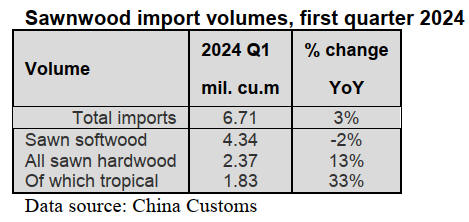

Surge in sawnwood imports from Thailand
Russia was, as in previous quarters, the largest supplier of
China’s sawnwood imports in the first quarter of 2024.
The proportion of China’s sawnwood imports from Russia
accounted for 43% of the total sawnwood import volume.
China’s sawnwood imports from Russia rose 1% slightly
to 2.914 million cubic metres over the same period of
2023.
Thailand was the second largest supplier of sawnwood
imports in the first quarter of 2024. The proportion of
China’s sawnwood imports from Thailand accounted for
18% of the total sawnwood import volume.
China’s sawnwood imports from Thailand surged 44% to
1.223 million cubic metres over the same period of 2023.
China's sawnwood imports from Thailand have soared
mainly because of falling prices which, in part, are the
result of adjustments in Thailand's timber tariff policy in
2022.
China's sawnwood imports from USA decline
considerably in the first quarter of 2024 dropping 18% to
267,000 cubic metres over the same period of 2023.
In contrast, China’s sawnwood imports from Canada in the
first quarter of 2024 grew 17% to 382,000 cubic metres
over the same period of 2023.
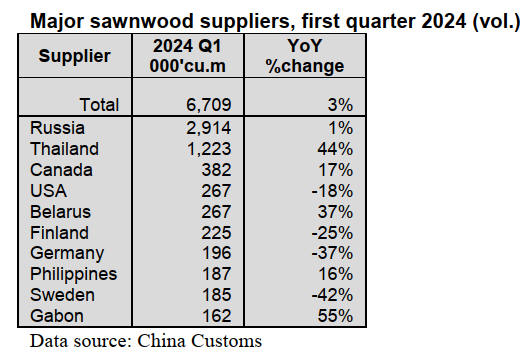

Main sawn softwood sources, first quarter of 2024
Russia was the largest supplier for China’s sawn softwood
imports in the first quarter 2024. 63% of China’s sawn
softwood imports are from Russia and imports from
Russia rose 5% to 2.713 million cubic metres in the first
quarter of 2024.
Imports from Canada and Belarus, the second and third
largest suppliers, rose 19% and 37% to 370,000 cubic
metres and 267,000 cubic metres respectively in the first
quarter of 2024.
In contrast, China’s sawn softwood imports from Finland,
Sweden and Germany fell 25%, 42% and 38%
respectively in the first quarter of 2024.
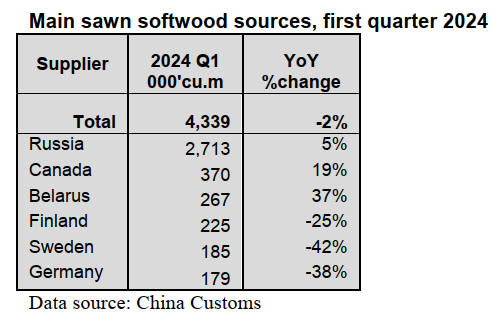
Main sawn hardwood sources, first quarter 2024
Thailand was the largest supplier for China’s sawn
hardwood imports in the first quarter of 2024. 52% of
China’s sawn hardwood imports are from Thailand and
imports from Thailand soared 44% to 1.223 million cubic
metres in the first quarter of 2024.
However, USA and Russia, the second and third largest
suppliers of China’s sawn hardwood imports fell 24% and
31% to 226,000 cubic metres and 200,000 cubic metres
respectively in the first quarter of 2024.
China’s sawn hardwood imports from the Philippines and
Gabon grew 16% and 55% respectively in the first quarter
of 2024. 84% of China’s sawn hardwood imports were
from five countries in the first quarter of 2024.
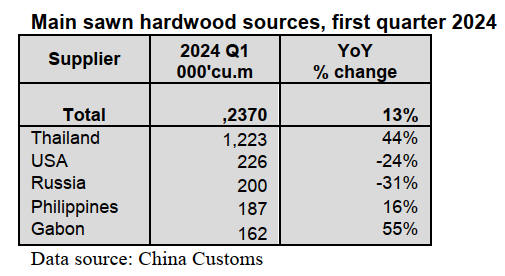
Significant rise in tropical sawnwood imports
China’s tropical sawnwood imports rose 33% to 1.829
million cubic metres in the first quarter of 2024. The top
three suppliers of China’s tropical sawnwood imports were
Thailand (67%), Philippines (10%) and Gabon (9%). 86%
of China’s tropical sawnwood imports were from these
three countries in the first quarter of 2024.
Meanwhile, China’s tropical sawnwood imports from
Thailand, Philippines and Gabon grew by 44%, 16% and
55% to 1.223 million cubic metres, 187,000 cubic metres
and 162,000 cubic metres respectively in the first quarter
of 2024.
China’s tropical sawnwood imports from Vietnam and
Malaysia also surged 65% and 80% respectively in the
first quarter of 2024. The significant rise in total tropical
sawnwood imports resulted from the rise in imports from
most of the top source countries.
In contrast, China’s tropical sawnwood imports from
Cameroon and the Republic of Congo dropped 16% and
9% respectively in the first quarter of 2024.
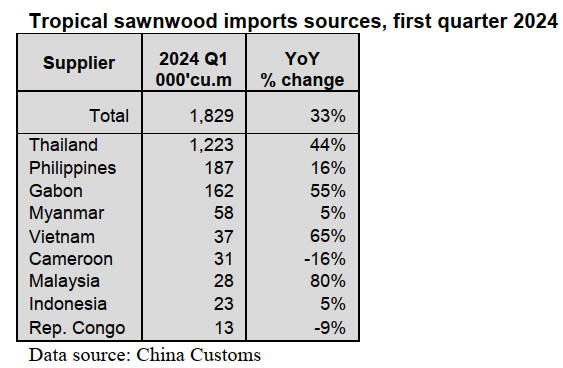
Decline in average CIF price for tropical sawnwood
imports
The average CIF price for China’s tropical sawnwood
imports in the first quarter of 2024 declined by 6% to
US$280 per cubic metres over the same period of 2023.
The CIF prices for sawnwood from the top suppliers did
not change significantly.
For example, the avarge CIF price for China's tropical
sawnwood imports from Thailand in the first quarter of
2024 just rose 1% and from the Philippines prices dropped
0.1%.
The CIF price for China’s tropical sawnwood imports
from the Republic of Congo in the first quarter of 2024
rose the biggest and by 11% over the same period of 2023.
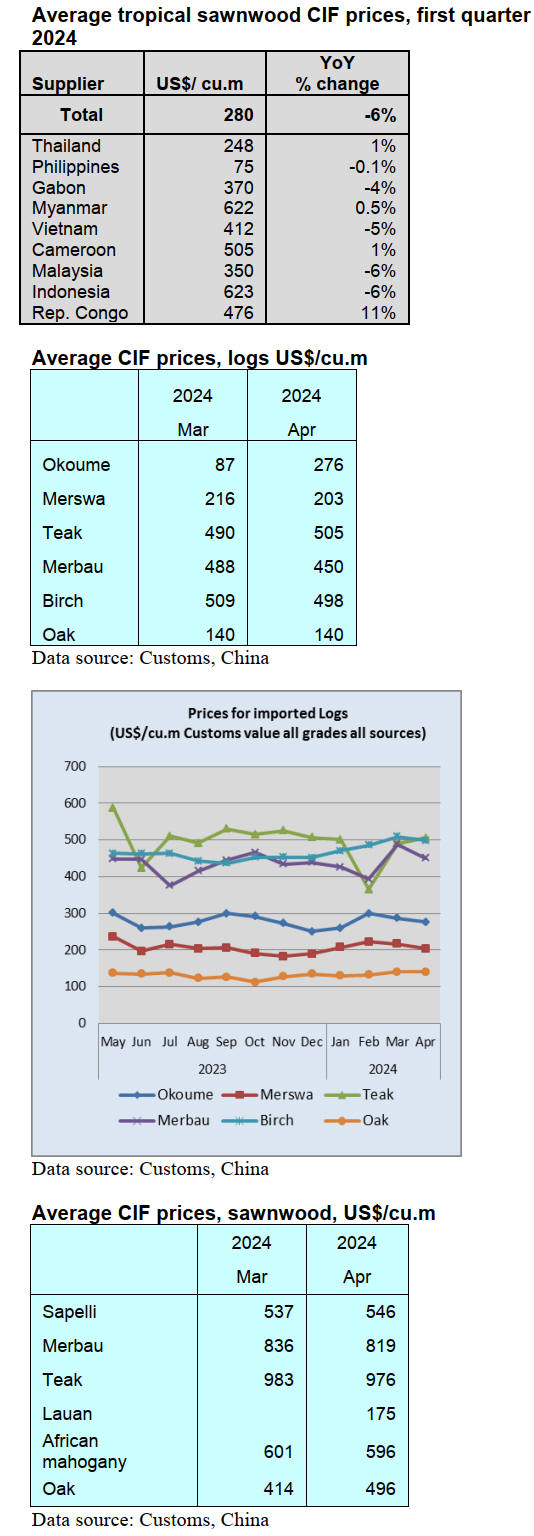

|